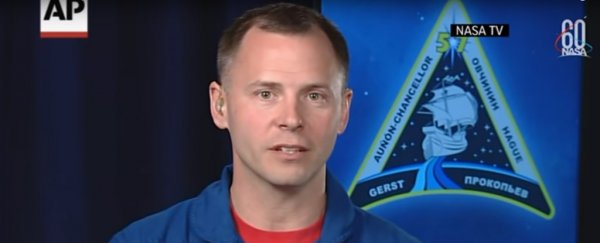Last week, NASA astronaut Air Force Colonel Nick Hague faced death as he and his commander, Alexei Ovchinin, plummeted to Earth following an aborted Soyuz launch.
Outside, the world held its breath as the spacecraft returned in what NASA called a "ballistic descent mode". Inside the tiny capsule, according to Hague, things got pretty rough.
"We knew that if we wanted to be successful, we needed to stay calm and we needed to execute the procedures in front of us as smoothly and efficiently as we could," Hague told The Associated Press.
It's the kind of event pilots prepare for while hoping they never need to put it into practice.
Minutes after launch, following the jettisoning of side boosters, a second stage booster on Ovchinin and Hague's Soyuz MS-10 spacecraft system failed, leaving them no option but to abort the mission barely halfway to the edge of space.
Getting back down again was anything but a gentle ride, and there was no promise of success.
"Any time you're launching yourself into space and your booster has a problem when you're going 1,800 metres per second, things are pretty dynamic and they happen very fast," says Hague.
Most of us might turn into a blubbering mess. But two years of training in Russia kicked in for Hague, who not only stuck to emergency procedures during the half hour descent, but did so in a second language.
"All of my instincts and reflexes inside the capsule are to speak Russian," says Hague.
Both astronauts touched down safely on a plain in Kazakhstan without injuries, where they immediately called Mission Control, followed by their wives. Hague's call went to voicemail.
What do you say when you've just stared death in the face from nearly 50 kilometres (31 miles) above the surface?
"I told her, 'I'm fine and it was one wild ride,'" says Hague.
One wild ride is what most of us might call a Japanese roller coaster. This was something else.
Just as the team was seeing the horizon curve and the atmosphere fade to black, warning lights indicated a problem.
"I knew once I saw that light that we had an emergency with the booster, that at that point we weren't going to make it to orbit that day – so the mission changed to getting back down on the ground as safely as we could," says Hague.
With alarms blaring, the capsule was violently thrown clear from the booster. The steady acceleration towards space was swapped for a moment of weightlessness, followed by a build of force equal to nearly seven times Earth's gravity.
Finally the parachutes snapped into place with a bone-jarring crunch, slowing the descent enough to avoid a deadly collision with the ground.
It might not have been a leisurely float to safety, but the system was designed to be efficient, not pleasant.
Soyuz's safety mechanisms have been a part of the system for decades. And this is the first time they've been deployed.
"That's the system that saved our lives, and Alexey and I are standing because of that," says Hague.
"It's on every rocket, and for manned launches on the Soyuz, they haven't had to use that system for 35 years, but it's always been there. It's always been ready, and we proved that last week."
It's been 15 years since NASA lost the entire crew of the Columbia space shuttle upon re-entering Earth's atmosphere. Since then, their fatality record on space missions has fortunately been a clean one.
Hague doesn't attribute his fate to luck.
"The Soyuz is an engineering marvel," says Hague.
"That thing is reliable, and I'm just glad that there are so many people that have invested so many years of their life making that system as strong as it is."
You can watch Hague explain his 'wild ride' below.
